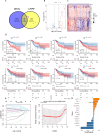CXCL8 is essential for cervical cancer cell acquired radioresistance and acts as a promising therapeutic target in cervical cancer
- PMID: 40596054
- PMCID: PMC12219856
- DOI: 10.1038/s41598-025-05435-w
CXCL8 is essential for cervical cancer cell acquired radioresistance and acts as a promising therapeutic target in cervical cancer
Abstract
Acquired radioresistance critically challenges cervical cancer radiotherapy management. Clinically relevant radioresistant cell models remain scarce, and CXCL8's role in cervical cancer-despite its tumorigenic/therapy-resistant associations in other cancers-is poorly characterized. Two radioresistant cervical cancer cell strains were established. mRNA-seq and bioinformatics analysis of radiosensitivity regulators identified CXCL8 as a key mediator. In vitro, assays of cell viability, clone formation, apoptosis and cell cycle were conducted following transient transfection of cervical cancer radiotherapy-resistant cell strains with knockdown of CXCL8, as well as subsequent addition of exogenous CXCL8 to cervical cancer parental cell strains. Radioresistant cervical cancer cell lines (Hela-RR/Siha-RR) were established through clinical protocol-mimicking irradiation, validated via proliferation/clonogenic/cell cycle assays. mRNA-seq identified 50 co-upregulated and 54 co-downregulated genes in resistant strains, with CXCL8 among top differentially expressed genes (IL11, CXCL8, MMP1, HSPA8, CA9, PPFIA4, EDN2, GUCY1A2, EFNA3, TNFAIP6). qRT-PCR confirmed CXCL8, TNFAIP6, SRNA8 and PPFIA4 dysregulation. Cox regression analysis of 96 candidate radiosensitivity regulators prioritized CXCL8 among eight key genes in cervical cancer. GEPIA2 and immunohistochemistry revealed CXCL8 overexpression in tumors. Functional studies demonstrated CXCL8 knockdown sensitized resistant cells to radiation, while exogenous CXCL8 induced resistance in parental lines.
Keywords: CXCL8; Cervical cancer; Radioresistance; Radiosensitization; Tumor microenvironment.
© 2025. The Author(s).
Conflict of interest statement
Declarations. Competing interests: The authors declare no competing interests. Institutional review board approval: This study was approved by the Ethics Committee of The First Affiliated Hospital of Zhengzhou University. Informed consent: N/A. Registry and registration number: N/A. Animal studies: N/A.
Figures










Similar articles
-
IRAK1 deficiency potentiates the efficacy of radiotherapy in repressing cervical cancer development.Cell Signal. 2024 Jul;119:111192. doi: 10.1016/j.cellsig.2024.111192. Epub 2024 Apr 27. Cell Signal. 2024. PMID: 38685522
-
Cryptotanshinone Inhibits Obesity-Related Cervical Cancer by Downregulating CXCL8 Expression in Hela Cells.Chem Biodivers. 2025 Jun;22(6):e202403263. doi: 10.1002/cbdv.202403263. Epub 2025 Feb 20. Chem Biodivers. 2025. PMID: 39921242
-
Identification of heat shock protein 27 as a radioresistance-related protein in nasopharyngeal carcinoma cells.J Cancer Res Clin Oncol. 2012 Dec;138(12):2117-25. doi: 10.1007/s00432-012-1293-0. Epub 2012 Jul 31. J Cancer Res Clin Oncol. 2012. PMID: 22847231 Free PMC article.
-
Hyperbaric oxygenation for tumour sensitisation to radiotherapy.Cochrane Database Syst Rev. 2018 Apr 11;4(4):CD005007. doi: 10.1002/14651858.CD005007.pub4. Cochrane Database Syst Rev. 2018. PMID: 29637538 Free PMC article.
-
Radiation therapy for triple-negative breast cancer: emerging role of microRNAs as biomarkers and radiosensitivity modifiers. A systematic review.Breast Cancer Res Treat. 2022 Jun;193(2):265-279. doi: 10.1007/s10549-022-06533-3. Epub 2022 Apr 9. Breast Cancer Res Treat. 2022. PMID: 35397079
Cited by
-
Identification and validation of ubiquitination-related genes for predicting cervical cancer outcome.Front Genet. 2025 Jul 30;16:1578075. doi: 10.3389/fgene.2025.1578075. eCollection 2025. Front Genet. 2025. PMID: 40809844 Free PMC article.
References
-
- Yadav, G., Srinivasan, G. & Jain, A. Cervical cancer: novel treatment strategies offer renewed optimism. Pathol. Res. Pract.254, 155136 (2024). - PubMed
-
- Observatory, G. C. Cancer over time.
-
- Siegel, R., Miller, K. & Wagle, N. Cancer statistics, 73, 17–48 (2023). (2023). - PubMed
-
- Jemal, A., Bray, F. & Center, M. Global Cancer Stat.61, 69–90 (2011). - PubMed
-
- Green, J. A. et al. Survival and recurrence after concomitant chemotherapy and radiotherapy for cancer of the uterine cervix: a systematic review and meta-analysis. Lancet358, 781–786 (2001). - PubMed

